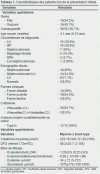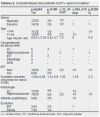Primary hyperoxaluria type 1: Clinical, genetic, and evolutionary characteristics in Tunisian children
- PMID: 38445424
- PMCID: PMC11217970
Primary hyperoxaluria type 1: Clinical, genetic, and evolutionary characteristics in Tunisian children
Abstract
Introduction: There are three types of primary hyperoxaluria, with type 1 considered the most severe.
Aim: To analyze the clinical, genetic, and evolutionary characteristics of type 1 primary hyperoxaluria with pediatric onset.
Methods: This was a retrospective, descriptive study that included Tunisian children under the age of 18 at the time of diagnosis over a period of 25 years (January 1, 1996, to December 31, 2022).
Results: Thirty-five patients were included, with a mean age of 4.1 years. The most common presenting circumstances of the disease were nephrolithiasis and end-stage renal failure. The average serum creatinine level was 225.42 µmol/l. Five mutations were identified, with the p.Ile244Thr mutation being the most prevalent. Nephrocalcinosis, surgical intervention, and a creatinine level ≥57 µmol/l were predictive of progression to end-stage renal failure. The infantile form was predictive of mortality.
Conclusions: Screening for the disease would improve the prognosis of this condition.
Introduction: Trois types d’hyperoxaluries primitives existent, le type 1 est considéré comme le plus grave. Objectif: Analyser les particularités cliniques, génétiques et évolutives de l’hyperoxalurie primitive de type 1 à début pédiatrique.Méthodes: Il s’agit d’une étude rétrospective, descriptive ayant inclus les enfants tunisiens âgés de moins de 18 ans au moment du diagnostic sur une période de 27 ans (1er Janvier 1996-31 Décembre 2022).Résultats: Trente-cinq patients ont été inclus, l’âge moyen était de 4,1 ans. Les circonstances de découverte de la maladie étaient dominées par la néphrolithiase et l’insuffisance rénale terminale. La créatinine sanguine moyenne était de 225,42 µmol/l. Cinq mutations ont été identifiées, dominées par la mutation p.Ile244Thr. La néphrocalcinose, l’intervention chirurgicale, une créatinine≥57 µmol/l étaient prédictives d’évolution vers l’insuffisance rénale terminale. La forme infantile était prédictive de décès. Conclusions: Un dépistage de la maladie permettrait d’améliorer le pronostic de cette pathologie
Figures





Similar articles
-
[Primary hyperoxaluria in children in central Tunisia].Tunis Med. 2007 Jun;85(6):513-8. Tunis Med. 2007. PMID: 17644908 French.
-
Clinical spectrum of primary hyperoxaluria type 1: Experience of a tertiary center.Nephrol Ther. 2017 May;13(3):176-182. doi: 10.1016/j.nephro.2016.08.002. Epub 2017 Feb 1. Nephrol Ther. 2017. PMID: 28161266 Free PMC article.
-
[Clinical analysis of seven cases with primary hyperoxaluria type 1 in children].Zhonghua Er Ke Za Zhi. 2020 Feb 2;58(2):129-134. doi: 10.3760/cma.j.issn.0578-1310.2020.02.012. Zhonghua Er Ke Za Zhi. 2020. PMID: 32102150 Review. Chinese.
-
Clinical features of genetically confirmed patients with primary hyperoxaluria identified by clinical indication versus familial screening.Kidney Int. 2020 Apr;97(4):786-792. doi: 10.1016/j.kint.2019.11.023. Epub 2019 Dec 13. Kidney Int. 2020. PMID: 32093915 Free PMC article.
-
Primary hyperoxaluria type 2.Eur J Pediatr. 1997 Jul;156(7):509-12. doi: 10.1007/s004310050649. Eur J Pediatr. 1997. PMID: 9243228 Review.
Cited by
-
Mutation Characteristics of Primary Hyperoxaluria in the Chinese Population and Current International Diagnosis and Treatment Status.Kidney Dis (Basel). 2024 Jun 17;10(4):313-326. doi: 10.1159/000539516. eCollection 2024 Aug. Kidney Dis (Basel). 2024. PMID: 39131880 Free PMC article. Review.
References
-
- Ben-Shalom E, Frishberg Y. Primary hyperoxalurias: diagnosis and treatment. Pediatr Nephrol. 2015;30(10):1781–1791. - PubMed
-
- Bouzidi H, Majdoub A, Daudon M, Najjar MF. Primary hyperoxaluria: a review. Nephrol Ther. 2016;12(6):431–436. - PubMed
-
- Hoppe B. An update on primary hyperoxaluria. Nat Rev Nephrol. 2012;8(8):467–475. - PubMed
-
- Cochat P, Rumsby G. Primary hyperoxaluria. N Engl J Med. 2013;369(7):649–658. - PubMed
Publication types
MeSH terms
Supplementary concepts
LinkOut - more resources
Full Text Sources
Medical

